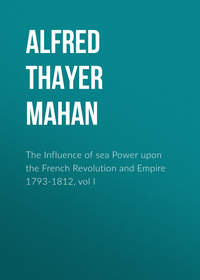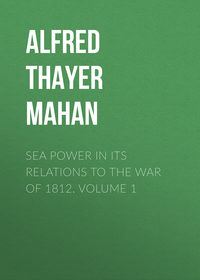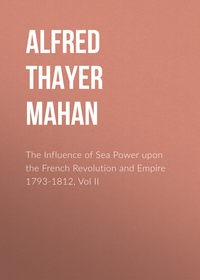 полная версия
полная версияStory of the War in South Africa, 1899-1900
It was a natural result of such prepossessions that, instead of concentrating to hold in mass some decisive position by which to prolong the war, or to destroy or capture some important detachment—such as that at Ladysmith—they should settle themselves down to sieges, to a war of posts. In 1881, of several posts they had in the same manner leisurely invested, one surrendered. They probably believed that the others would have done so, had not the British Government of that day yielded and made peace. Whatever the reasoning, it was to the method of 1881 that the Boers resorted. After the preliminary battles in Natal, already narrated, in each of which the British attacked, they settled down with facile indolence to an investment of Ladysmith.
The dissemination of the enemy on the Free State frontier, so graphically summarized by Steevens, could not induce them to crush, with the concentrated force permitted by their imposing superiority of numbers, any one of the small detachments thus fatally exposed. The place, not the force within, had military value in their eyes. To the general result contributed no doubt the tendency of local interest to dominate general considerations in a rural and loosely organised population. It was noted at the time that the principle of local operation decided not only that the Transvaal should operate chiefly in Natal, and the Orange Free State toward Cape Colony, but also determined the course of action within each state. "There has been very little moving about of burghers from one part of the Transvaal or Free State to the other.... In the latter, the eastern commandos have gone to Natal, the western ones to Kimberley, and to the southern ones, numbering probably less than 4,000 men altogether, have been left the double task of invading Cape Colony and keeping off the Basutos; and as the ordinary Free State burgher is much more anxious about his own farm than about turning our colony upside down, the result is that practically nothing has been done to attack the most vulnerable point in our defence."
The same correspondent, writing from Cape Town, October 25, said that there were not 3,000 men of regular troops, and no artillery, in Cape Colony when the war broke out. His means of information were doubtless better than those of Steevens, who was in Cape Town less than forty-eight hours and made his guess—4,100—before he had time for personal observation over the ground.
It is scarcely necessary to point out what an opportunity was here presented for a rapid succession of blows at isolated detachments, such as military history has often before witnessed. It is difficult to believe that the frontier could not have been swept clean from end to end, and the entire railroad system, essential to the advance and centralised action of the British forces, hopelessly dislocated and smashed by an operation embodying the most elementary conceptions of concentration. Instead of that the centre of the line was kept almost undisturbed, the principal demonstrations of the Boers across the border being on the flanks—Kimberley and Mafeking on their right, Stormberg and the districts north and east of it on their left; the railroad from Naauwport to De Aar, and thence to the Orange River, being scarcely molested, and for working purposes remaining intact. So far as military purpose can be inferred from military action, the effort of the Boers was concentrated—or rather localised—upon the occupation of unprotected and friendly districts in the east, where they took up scattered defensive positions, while for offensive operations they satisfied themselves with the investment of Kimberley and Mafeking.
An American correspondent—evidently not unfriendly—writing of Pretoria about October 20, records an instructive anecdote, which reveals much of the Boer idea and purpose, and suggests food for thought as to underlying causes, not unprecedented in history, which from the first, if then known, would have foretold sure defeat. "A large door on the opposite side of the room opened, and a clerk informed the Secretary (Mr. Reitz) that he was wanted in the Executive Council room. While he was collecting a number of papers on his desk I could hear the conversation of men in the adjoining room. Suddenly there was a deep roar—almost like that of a lion—and at the same time a bang on the table that made the windows rattle. And the voice—it was that of a man—continued its deep bellowing, and again there was a thundering bang on the table. 'The old President has met with some obstacle in his plans,' said the Secretary of State, smiling at my look of surprise at the sound of such a human voice, and he disappeared with an armload of papers.... When he returned he was chuckling to himself. 'General Cronje wants to assault Mafeking,' he said. 'He has wired that he can take the town in a hand-to-hand fight, but the old President won't listen to it. He says the place is not worth the lives of fifty burghers, and has just issued an order that Cronje is to continue the siege and simply see to it that Colonel Baden-Powell and his troops do not escape. The Council was divided; some thought that Cronje should be permitted to storm the place. The President has just ordered that one of the big siege-guns shall be sent to Cronje.'"10
Time apparently was of no account. The burghers and the Boers had only to wait open-mouthed for plums to drop—at Mafeking, at Kimberley, at Ladysmith. Mafeking very possibly was not in itself worth the lives of fifty burghers; but it was worth a great deal more if it was to be the means of detaining them before its little worth to their exclusion from action concentrated elsewhere, which their numbers would have gone to make overpowering, and which by proper direction would have been decisive—not perhaps of ultimate issues—but of those prolonged delays in which lies the best hope of a defence. It is an interesting commentary on Kruger's decision that, at the moment these lines are writing, the deliverance of Mafeking is known to have been preceded immediately by a fruitless assault of the burghers, which cost more than that presumed for the attack at the outset, which a competent general on the spot believed then would be successful. Control at a distant capital, exercised by an obstinate, overbearing old man, who, though unquestionably shrewd and acute, was equally unquestionably narrow with the narrowness of contracted experience and limited military knowledge, boded ill for the Boer cause. While Cronje at Mafeking, and Wessels at Kimberley, and Joubert at Ladysmith were waiting for a moment that never came, time was flying, the hostile reinforcements were speeding forward 300 miles a day, and the very danger of the three places was goading the British people into wide-awake activity.
Yet more imminent was the nearer opportunity, fast disappearing into the nearer danger, ultimately to become the established and fatal centre of ruin—at De Aar. "This was not the sort of fighting-ground the Boer is wont to choose," wrote one there present, "but we felt that he must come because we menaced his frontier sixty miles away, and tempted him with such an amount of stores, guns, and ammunition as would enable him to prolong his warfare at least two months longer than his own resources would permit." A somewhat narrow view this, leaving out of the account De Aar's intrinsic advantage in position; but to continue—"Every day that the Boers delayed our camp grew stronger, though this was not the case before General Buller arrived at the Cape (October 31). Until then we had only one battalion—about 800 men—to protect stores estimated at half a million pounds; but within forty-eight hours a battery and a half—nine guns—had arrived from England, to be followed by another half battery from the Orange River."11
The position of De Aar indicated it absolutely as a point which the British must hold, fortify, and use as a depot and base. Camps and buildings began to be laid out and put up about October 25, and stores to accumulate; ten days later came the batteries and also reinforcements; but these—400 in number—imperatively demanded by the superior importance and exposure of De Aar, which required concentration upon it, were obtained by evacuating Colesberg and Naauwport, the latter a most regrettable necessity. But what were the Boers doing while these fragments were drawing together into a single body, while batteries were arriving, and works, not yet existent, were being thrown up? They were besieging Kimberley and Mafeking, 150 and 300 miles away, and pottering about just within Cape Colony, occupying undefended towns and making proclamations of annexation. "Fancy," says the writer just quoted,—"fancy the Orange River sixty miles away, with 2,500 men (British) holding the (railroad) bridge over it, and a battalion of 1,000 men broken into five bodies of troops isolated at as many points—all, excepting the force at Orange River, inviting certain destruction."12
The concentration ordered by Buller, just mentioned, drew the British, on the left flank of their line in Cape Colony, into two principal bodies—2,500 at Orange River Station, where the railroad to Kimberley crosses the river, and some 1,500 at De Aar. Stormberg Junction on the right of the line was evacuated at the same time as Naauwport, the troops falling back upon Queenstown, fifty miles distant by rail. This abandonment of the two junctions severed from each other the right and left flanks of the general front, which extended from Stormberg to De Aar, depriving them of mutual support; a condition of disadvantage that was not wholly removed until after the occupation of Bloemfontein. This gain to the Boers, however, was due to no well-combined active operations on their side, but to the mere fact that their opponents were everywhere so hopelessly weaker in numbers that it was insanity any longer to risk these small detachments in places where they ought to have been captured days before.
From these withdrawals it resulted that the British movements in either quarter were of no assistance to those in the other by direct co-operation, but only by diversion—by occupying in front of either flank a certain proportion of the enemy. The latter attempted no serious movement of attack, but simply waited. Their plan, alike in the strategy of the campaign and in the tactics of the battlefield, was to abide attack, with the advantages, usual to the defensive, of a carefully chosen position diligently improved. So placed and secured, they hoped to repel and to hold fast; but at the worst to inflict loss greater than they received and then to slip away successfully, avoiding capture, to another similar position in the rear of the first, there to repeat again the same tactic. For such retreat provision of horse mounts was always carefully made, and to its success their superiority in horseflesh, their habit of isolated movement, their knowledge of the country, and the friendliness of the inhabitants, greatly contributed. The student of naval history will easily recognise in these methods an analogy to the battle tactics plausibly ascribed to the French by Clerk in his celebrated treatise. It was often successful on the ground, but it did not win campaigns. The mastery of the sea remained with the British, whose blindly headlong attacks with their ships resembled in much the free and often foolish exposure of their troops in the beginning of the present war. Nevertheless, the temper is one which wins, nor is there any necessary incompatibility between a vigorous initiative and reasonable caution.
There is much to be said for such a plan as suited to the force numerically inferior, and especially when, as with the Boers, it is composed of men untutored in the military formations and manœuvres essential to successful movement in battle. Defence of the character indicated requires little change after the primary dispositions have been made; the men for the most part stand fast when placed, and do not incur the risk of confusion from which the well-practised only can extricate themselves.
The mistake of the Boers was in failing to recognise that a nation compelled to such a mode of action by its conditions of inferiority, in numbers and in drill, is doomed to ultimate defeat, unless at the very beginning, while the enemy has not yet developed or concentrated his powers, such an advantage is gained by a vigorous initiative as shall either prevent his obtaining the necessary initial positions, or shall at least postpone his doing so long enough to affect materially the course of the war, and give room for the chapter of accidents—for the intervention of the unforeseen. The Boers, having surprised their enemy at unawares, had the opportunity so to act. It may be that, had they done so, ultimate success would not certainly have followed—the odds were very great; but it is safe to say that only so, by rushing the campaign at the beginning, had they any chance of final victory. "Desperate conditions," said Nelson, "require desperate remedies." The Boers' position was desperate from the first, to be saved only by the most vigorous handling of numbers which for a brief and critical period were largely superior.
Thus it was that these opening weeks decided the character and issue of the war, beyond chance of subsequent reversal. By the Boers' own choice, interest was fixed not upon one or two, but upon several quarters, and these—save Ladysmith—determined not by their inherent, and therefore lasting and decisive, strategic importance, but by questions of commercial value and of the somewhat accidental presence in them of very small bodies of regular troops. At two places, Mafeking and Kimberley, the assailants were, as an English journal justly put it, "foiled by colonial forces hastily organised, and stiffened by small regular detachments which have shown far more enterprise on the offensive than their besiegers have done."
Such a situation, under the existing conditions of the general campaign, should have been met, not by protracted investment in force, but by assault; or, if that were inexpedient, a sufficient detachment should have been left to hold the garrison in check, while considerations of more decisive military importance elsewhere received concentrated attention.
Immediately after the arrival of Sir Redvers Buller he found the investment of the three garrisons—Ladysmith, Kimberley, and Mafeking—already accomplished. The question before him was complicated by the introduction of these new factors. As has before been said, it is generally understood that the expectation of the British authorities had been to proceed at once to an invasion of the Orange Free State, presumably by the line to Bloemfontein, with flanking movements on either side of it, while the forces in Natal were to stand simply on the defensive, until, by the advance of the army of invasion within supporting distance, the time for co-operation with it should arrive. In Natal, now, the tables were turned, the defence had broken down, and the army charged with it was shut up by a force so far superior as to enable it, not only to carry on the siege, but to make at least serious inroads upon the colony, if not to advance permanently to positions of more extensive control, to dislodge it from which greater effort would be needed. The question now to be decided was whether relief would be best effected by adhering to the original plan of moving in force upon Bloemfontein, leaving Ladysmith to look out for itself, and only strengthening the forces in Natal outside of the place sufficiently to check any further advance of the enemy; or whether to attempt speedier succour by a direct advance along the roads leading to one or both of the besieged places.
The first, if successfully carried out, would eventually take in the rear the assailants both of Kimberley and Ladysmith, threatening them with the severance of their communications—concerning which the Boers are exceptionally sensitive—and thus would raise the siege by compelling the retreat of the besiegers. This plan, moreover, would be faithful to general military principle, by keeping the great mass of the British Army concentrated upon a single object, and under a single hand.
The alternative possessed the drawback of dividing the army into two bodies virtually independent in their several movements, out of mutual supporting distance, and each distinctly weaker than the single mass intended for the great central operation of the former plan. The second also laboured under the other disadvantages that a direct advance naturally has as compared to a turning movement. The enemy would be met always in front—thus covering his communications and with retreat open—in positions assumed tactically with a view to prevent flank attacks and to compel assault in front, the most dangerous to make.
In choosing their ground for their objects, the Boers have shown remarkable aptitude. If overpowered and dislodged, unless routed and dispersed, the defender falls back continually upon the bases in his rear, recuperating his losses by reinforcements from them, while the victorious assailant must either press on with diminished numbers or must wait for reinforcements to come up, a delay that enables the defence still more to improve the next position, which, in a campaign of this sort, has commonly been selected long before. It may be said here that this was precisely the character of the advance on Kimberley about to be narrated. In such a direct operation, by its very nature, the defence gains strength and shortens his line of communications to be defended, while the reverse conditions unremittingly drain the powers of the assailant.
As an abstract military question there need be no hesitation in saying that the advance through the Orange Free State was in principle the correct plan, even under the existing conditions, as far as these are accurately known. But conditions are never accurately known to outsiders so immediately after a war. Even the hard bottom facts which ultimately appear, the residuum left after full publicity, and discussion, and side lights from all sources have done their work, do not correctly reproduce the circumstances as present to the mind of the general officer who decides. What is known now was doubtful then; what now is past and certain, was then future and contingent; what this and that subordinate, this force and that force could endure and would endure we now know, but who could surely tell six months ago? Who, whatever his faith in the heroism and patience of the garrisons, believed in December, 1899, that Ladysmith and Kimberley and Mafeking could hold out, without relief, as long as they did? What therefore, between the known uncertainties of the past and the certainly imperfect information of the present, we, who had not the responsibilities of decision, may modestly refrain from positively judging the particular decision, even by the generally sound principles which commonly govern such cases. Warfare is an art, not a science; it knows no unvarying laws, and possesses neither specifics nor panaceas.
Whatever the reason, the decision was reached to attempt simultaneously the relief of Kimberley and of Ladysmith. It is with the former, which also was first in order of time, that we now have immediately to do. This advance had begun, had reached its furthest limit, had been brought to a standstill, and so had failed, before the clash of arms at Colenso, on December 15, signalized the opening of the campaign for the relief of Ladysmith. This priority was naturally to be expected; for not only was Cape Town the first port of arrival from England, but the much larger number of the besiegers at Ladysmith made a much longer time necessary to accumulate the force adequate to contend successfully against them. The details of the assembling of Methuen's division at Orange River Station need not detain us. The 2,500 men there in the first week of November had been increased by November 19 to nearly 10,000, and began to advance on the 21st. It will be well, however, to say a word about their objective, Kimberley, its conditions, its defences, and its defenders, as well as about the country through which runs the railroad that marks the general line of Methuen's proposed operation.
Lieutenant-Colonel Kekewich, who had been ordered to command the forces in Kimberley, had arrived there on the 13th of September. Already portions of the Transvaal levies were out, "on commando," as the Boer phrase is, moving on the Free State side of the boundary line; and many reasonably authenticated rumours were heard of intentions to destroy the railroad bridges—notably over the Modder and Orange Rivers—south of the place, as well as others north of it. The guard of the road generally was then in charge of a mounted body called the Cape Police, detachments of which watched the bridges. Political and other considerations prevented immediate steps from being taken to fortify the town, but plans were matured, and information concerning the surrounding country had already been procured by subordinate officers, whose arrival had preceded that of Kekewich. On the 18th of September, construction of defence works began, reports of movements by the burghers of the Free State as well as by Transvaalers being received, and arousing apprehension of a sudden attack. On the 27th of September, an officer of the garrison, by personal observation at Boshof in the Free State, ascertained that the burghers of the latter had been ordered out. The works were then pressed forward, and the formation of citizens into town guards already planned, was begun; 1,156 combatant members being enrolled, and placed under drill by non-commissioned officers of the regular battalion in garrison. The Boer forces continued to approach Kimberley, and on October 4, a week before war began, advanced bodies were within twelve miles. By October 7 the earthworks were so far forward that Kekewich considered the place practically safe against any attempt on the part of the enemy to rush it suddenly.
When the ultimatum expired, October 11, the garrison proper consisted of 570 Imperial and 630 colonial troops, for the defence of an unwalled town which contained 40,000 inhabitants and, being built in rambling fashion, had a very long circuit—about eleven miles—to be guarded. The ready co-operation of the citizens in military duty, both those already belonging to volunteer bodies and those not previously organised, but now enrolling themselves for the purpose, alone made the defence possible. From them, particularly, was formed a corps of irregular horse, which filled the want of mounted troops that at first was severely felt. Colonel Kekewich, recognising the enemy's overpowering superiority of numbers, rapidly drew into Kimberley all the outlying forces of every character under his command.
Although deeply concerned for the safety of the Modder River bridge, upon which in a measure would depend the advance of a relief column, "I was most anxious," he says, "that no disposition of troops made by me should give the enemy a chance of scoring a first success, even where the smallest body of British troops might be concerned. Taking into consideration that the enemy would probably not regulate his movements in accordance with the dictates of sound strategy, that he was in possession of mobile artillery in my immediate neighbourhood, I felt that if I had detached a small body of troops, necessarily without artillery, which it was not in my power to support from Kimberley, the enemy would in all probability concentrate very superior numbers, with artillery, against the small British post, and endeavour to destroy the troops composing the same. It was principally for this reason that I determined to concentrate all my available forces, including the Cape Police, at the point of greatest importance in my command—Kimberley."
The inference of Colonel Kekewich as to the Boers' strategy was as accurate as his general action was militarily judicious. The concentration and development of his resources not merely deterred the enemy from assault, but detained them there in force, to the neglect of matters elsewhere much more urgently worthy of their efforts. The gain of Kimberley, had they gained it, would have been poor compensation for the daily increasing solidity of the still weak British grasp on the central positions outlined by De Aar, Orange River and Naauwport. This absorption of the Boers' attention by Kimberley was maintained by frequent sorties of the garrison, in every direction, which at an early period of the siege became possible through the ready facility with which the citizens were converted into irregular mounted troops. "It will be observed," wrote Kekewich, "that portions of the mounted corps were employed on every occasion" of the continued sallies in greater or less force, especially at the period of Methuen's advance.











